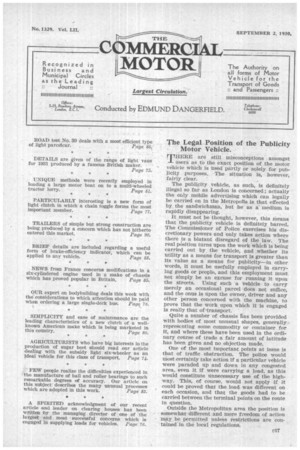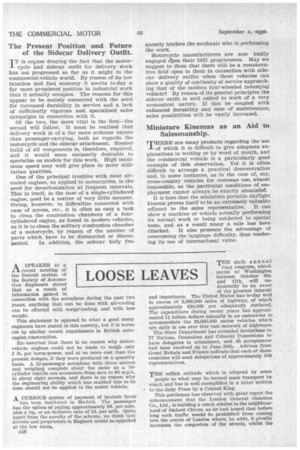The Legal Position of the Publicity Motor Vehicle.
Page 39

Page 40

If you've noticed an error in this article please click here to report it so we can fix it.
THERE are still misconceptions amongst users as fo the exact position of the motor vehicle which is used -partly or solely for publicity purposes. The situation is, however,
fairly clear. '
The publicity vehicle, as such, is definitely illegal so far as London is concerned ; actually the only mobile advertising which can legally be carried on in the Metropolis is that effected by the sandwichman, but he as a medium. is rapidly disappearing.
It must not be thought, however, this Means that the publicity vehicle is definitely barred. The Commissioner of Policeexercises his discretionary powers and only takes action where there is a blatant disregard of the law. The real position turns upon the work which is being carried out by the vehicle, and whether its utility as a means for transport is greater than its value as a means for publicity—in other words, it must be usefully employed in carrying goods or people, and this employment must not simply be an excuse for running it upon the streets. Using such 'a vehicle to carry merely an occasional parcel does not suffice, and the onus is upon the owner, driver and any other person concerned with the machine, to prove that the work upon which it is engaged is really that of Iransport.
Quite a number of chassis has been provided with bodies of most unusual shapes, generally representing some commodity or container for it, and where these have been used in the ordinary course of trade a fair amount of latitude has been given and no objection made.
One of the most important points at issue is that of traffic obstruction. The police would most certainly take action if a particular vehicle were paraded up and down in any congested area, even it if were carrying a load, as this would constitute unnecessary use of the highway. This, of course, would not apply if it could be proved that the load was different on each occasion, and that the goods had to be carried between the terminal points on the route in question.
Outside the Metropolitan area the position is somewhat different and more freedom of action may be permitted unless restrictions are contained-in the local regulations.
The Present Position and Future of the Sidecar Delivery Outfit.
TT is noluse denying the fact that the motor-1cycle and sidecar outfit for delivery work has not progressed so far as it might in the commercial-vehicle world. By reason of its low taxation and fuel economy it merits to-day a far more prominent position in industrial work than it actually occupies. The reasons for this appear to be mainly connected with the need for increased durability in service and a lack of sufficiently vigorous and specialized sales campaigns in connection with it.
Of the two, the more vital is the first—the second will follow. It must be realized that delivery work is of a far more arduous nature than passenger-carrying, both as regards the motorcycle and the sidecar attachment. Stouter build of all components is, therefore, required, and it would seem eminently desirable to specialize on models for this work. High maximum speed may well give place to more utilitarian qualities.
One of the principal troubles with most aircooled engines, as applied to motorcycles, is the need for decarbonization at frequent intervals. This in itself, in the case of a single-cylindered engine, need be a matter of very little moment. Owing, however, to difficulties connected with ease of access, etc., it is often as easy a task to clean the combustion chambers of a fourcylindered engine, as found in modern vehicles, as it is to clean the solitary combustion chamber of a motorcycle, by reason of the number of parts which have to be dismantled or discon nected. In addition, the sidecar body fre quently hinders the mechanic who is performing the work.
Motorcycle manufacturers are now busily engaged trpon their 1931 programmes. May we suggest to them that there will be a remunerative field open to them in connection with sidecar delivery outfits when these vehicles can show a quality of continuity of service approaching that of the modern four-wheeled industriaj vehicle? By reason of its general principles the sidecar outfit is well suited to work of a very economical nature. If this be coupled with enhanced durability and ease of maintenance, sales possibilities will be vastly increased.
Miniature Kinemas as an Aid to Salesmanship.
THERE are many products regarding the use of which it is difficult to give adequate explanations in writing or by word of mouth, and the commercial vehicle is a particularly good example of this observation. Yet it is often difficult to arrange a practical demonstration and, in some instances, as in the case of, say, cross-country vehicles for overseas use, almost impossible, as the particular conditions of employment cannot always be exactly simulated.
It is here that the miniature portable daylight hinema proves itself to be an extremely valuable adjunct to the sales representative. It can show a machine or vehicle actually performing its normal work or being subjected to special tests, and as a result many a sale has been clinched. It also presents the advantage of overcoming the language difficulty, thus rendering its use of international value.












































































































